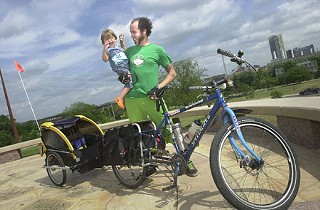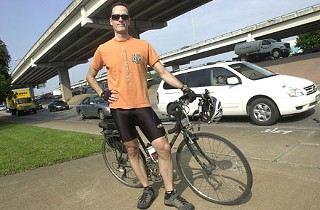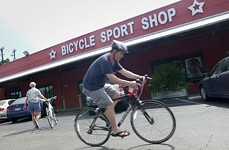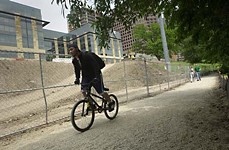The Revolution Will Not Be Motorized
Is Austin finally giving bicyclists a little respect?
By Daniel Mottola, Fri., May 9, 2008
"It's no longer just a bunch of weirdos in Lycra or anti-establishment punks. More Austinites are choosing to ride bikes for more than just recreation, and it is becoming very clear that the streets are not ready for it," said Kris Elkinton, a full-time bike mechanic at Austin's Bicycle Sport Shop. He doesn't own a car. "Now that I ride with my 2-year-old daughter, pretty safe conditions no longer cut it. I can never fully use the bike lanes without having to avoid debris, parked cars, trash cans, or disrepair, and the lanes end when approaching most high-traffic areas as if to say, 'Okay, we got you this far; now you're on your own!'" Through his job, Elkinton has observed a marked rise in transportation-bicycling interest this year, motivated most strongly, he says, "by the increasing price of gas and goods."
Bicycles also offer a remedy for some of Austin's other ills, like traffic congestion and worsening smog. But bicycling around Austin still ain't easy, especially for a novice. To entice nonbicyclists and predominantly recreational cyclists to begin pedaling for transportation, utilitarian bicycling must appear simple and safe. Despite signs of a growing groundswell in transportation cycling and bike culture among younger folks, not to mention a growing political force demanding bike reforms, few would claim that bicycling around Austin today is either simple or safe.
Fortunately, the city has recently responded in a welcome way, by kicking off a landmark update to Austin's Bicycle Plan, the city's 10-year-old road map to institutionalize bicycling as a viable mode of transportation. Based on two pro-bike City Council actions last month, the bike plan update appears to have the enthusiastic support of a sitting council that previously hadn't really gone out of its way to back bikes. In addition to voting in support of efforts to elevate Austin's official League of American Bicyclists bike-friendliness ranking from silver to gold, council voted to base the bike plan's update in large part on the recently completed recommendations of the Street Smarts Task Force – another very significant bike-mobility effort that aptly responded to demands that the city find ways to make cycling safer and more mainstream. Moreover, last week council also passed a resolution, sponsored by Council Member Sheryl Cole, to coordinate interdepartmental efforts to build off-road, interconnected bikeways through Austin's parks and green spaces.

In initiating both the bike plan update and Street Smarts Task Force, the city intends to create more transportation bicyclists. The next question is how to best prioritize the array of recommended reforms to that end. How should staff apply new infrastructure ideas cherry-picked from other bike-friendly cities, and how can bicycling be better promoted to citizens? Who should be targeted when planning new bike projects, and which types of projects will yield the best results: on-street bike lanes that get riders directly to their destination alongside traffic or meandering off-street paths that cater to traffic-shy, inexperienced cyclists?
And then there's funding. Can the plan's goals be accomplished in a timely fashion with the bike program's current project budget, roughly $2 million a year, or should a budgetary boost be used to build lots of infrastructure connectivity soon, making subsequent expenditures even more valuable? Seattle's bike program will spend about $5 million per year on bike projects over the next nine years, thanks to a property-tax levy tied for multimodal transportation improvements approved by voters in 2007. Austin's bike money comes primarily from bond funds.
One question planners already know the answer to is why people avoid transportation cycling: safety. In fact, the two most commonly cited factors are dangerous barriers, such as highway intersections and bridges, and fear of riding alongside fast-moving traffic.
Such persistent issues were taken into account in the city's original Bicycle Plan, passed in two phases in 1996 and 1998. Annick Beaudet, now the Public Works Department's Bicycle and Pedestrian Program project manager, was on staff in 1997 when, she says, the plan was regarded as national best practice. "Like any comprehensive plan, the Bicycle Master Plan is meant to be updated every five to 10 years," said Beaudet, who commutes to work by bike and cycles competitively. In terms of recommended infrastructure, the old bike plan is about 35% complete, based on linear miles of bike lanes, she said. That figure doesn't include complicated barrier-removal projects to navigate cyclists through impediments like highway interchanges or large undertakings like the Pfluger Bridge over Lady Bird Lake. Notably, Beaudet has been a strong force in moving the plan forward. As for its effectiveness, she said, "I believe transportation bicycling in the central city has skyrocketed." According to census data, bike commuting rose from 1.2% in 1990 to 1.7% in 2000 citywide and from 2.5% to 3.5% in the central city. When the 2010 census is taken, Beaudet expects bike commuting levels to be dramatically higher. The plan's goal was to have 4% of citywide commuters biking by this year and 8% by 2015.
Setting Wheels in Motion
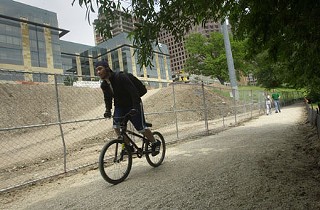
To get there, the updated bike plan will be redesigning its strategy. The biggest difference will be the way the bike program decides which projects to undertake first, Beaudet explained. Her staff will use a new, more specific prioritization matrix to expedite projects geared toward the "least-common-denominator or beginner cyclist." In general, she said, the bike plan is being refreshed rather than overhauled to reflect a larger Austin, new best practices, and new city policy. The updated plan will include a revised bike-route map and new street-posted maps delineating bike routes, she said. She also says she has realized that famously bike-friendly cities like Portland, Ore., credit their high ridership not just to good infrastructure but to the fact that they "promote the heck out of it." But the most important aspect of the bike plan update is certainly its inclusion of the pivotal Street Smarts recommendations.
With the goal of making Austin a "world class bicycling city," the work of the Street Smarts Task Force was a truly historic undertaking that allowed representatives from every local cycling stakeholder group (including the stronger than ever transportation-cycling-focused League of Bicycling Voters) to initiate a productive discourse with representatives from the medical community, the Austin Police Department, City Council staff, and the Texas Department of Transportation. Formed in response to bike-community outrage over a mandatory helmet law proposed in 2006, the broad-based task force drafted a comprehensive set of guidelines that articulates virtually all of the long-held goals of local transportation bicyclists. After 10 months of work that began last March, Street Smarts' subcommittees on infrastructure, law enforcement, and education and promotion democratically ratified a set of comprehensive recommendations. Some key suggestions include growing the city bike program's staff and budget, substantially increasing bicycling education and promotion, getting parked cars out of marked bike lanes, addressing conspicuous gaps in existing bike lane infrastructure, and installing showers, lockers, and secure parking around town to encourage bike commuting. Other infrastructure recommendations include "bike boxes," which establish a space for cyclists at some traffic-light-controlled intersections in front of cars and behind crosswalks to aid visibility, and "sharrows" – signs and street markings to indicate that it's legal and appropriate for cyclists to take the full lane on a two-lane road where a bike lane can't be installed. Task force Chair Sara Krause noted that the Law Enforcement Subcommittee's recommendations include, among other things, APD-backed efforts to improve data gathering and analysis on bike/auto collision hot spots around Austin – another longtime plea from the cycling community. Krause highlighted the Education and Promotion Subcommittee's recommendation that Austin borrow some common-courtesy tactics employed in Tucson, Ariz. Recounting a recent trip there, Krause said, "Share the road slogans and bike symbols were plastered all over bus benches and billboards, and bicyclists could grab pamphlets all over town that explained how to ride in traffic and at intersections and included a complete bike-route map." Krause said that even in inclement weather, she saw lots of locals biking.
In a presentation to City Council introducing the task force's recommendations, Krause cited a University of Minnesota study that partially focused on Austin and found that building bike facilities resulted in a greater transportation modal split. In other words, more people chose to bicycle vs. drive – findings Krause suggested were proof that bike investments pay off. The task force's infrastructure recommendations – a total of 101 of them – will cost an estimated $55 million, with another $1 million recommended annually for education and promotion. Since the task force went before 14 city departments, the hope is that each department will help achieve Street Smarts' objectives. Some examples of likely collaborations include a possible Austin Energy rebate for employers that install showers for commuters, using bike boulevards – proposed in the original plan to restrict automotive through-traffic to create designated bikeways on residential streets parallel to busy roads (think 46th Street or Nueces) – for neighborhood traffic-calming efforts, and including bicycle criteria in the city's site-development review process.
The symbolically pro-bike City Council vote directs the city manager to investigate how to include the Street Smarts Task Force's recommendations into the Austin Bicycle Plan update. Before that rubber meets the road, however, funding commitments will need to be made – and with budgetary shortfalls on the horizon, the council's true support for cycling as a dynamic transportation mode in Austin will remain uncertain until it puts cash behind these ambitious two-wheeled plans. The council is expected to officially enact the updated Bicycle Plan in December. It can't be denied, however, that at the moment, bicycle progress in Austin is moving along at an impressive pace – cyclists just hope the wheels don't come off.
Kris Elkinton, 31, bicycle mechanic
"Because I ride a bike, I've made the best friends of my entire life. Being a part of the local bike culture has shown me a fantastic side of this city that I probably would have overlooked otherwise. I also know that I wouldn't have been able to pursue the lifestyle and career I have if I would have been paying for a car over the last 11 years." Elkinton is perhaps most recognizable by his blue Xtracycle (a mountain bike that's been elongated and transformed into a so-called sports utility bike). He rides several times a week with his 2-year-old daughter in tow. The entire bike/trailer setup is nearly 11 feet long, about the same as a car. Elkinton and daughter Charis are pictured here at the newly christened Butler District Park, a favorite play destination next to Palmer Events Center.
In his spare time, Elkinton and a fellow Xtracycle-riding mechanic started Guerrilla Cyclewerx, which offers on-the-spot bike repair services at music shows and outdoor events for a modest fee. For more info, visit www.myspace.com/guerrilla_cyclewerx.
Jennifer Schaffer, 36, landscape designer
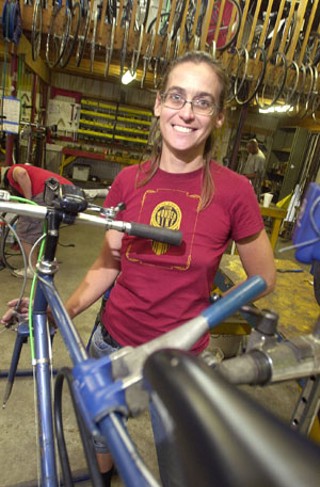
"I keep thinking I'm going to come up with some kind of clever or original reason for riding a bike as transportation, but the honest-to-God truth is that it's just the best, most logical option out there: It's clean, efficient, sustainable, healthy, cheap, easy, and so much more fun than driving!" A founding volunteer at Austin's Yellow Bike Project, Schaffer has worked to grow the collective's role as a steward of free community bike shops, in addition to fostering a new generation of citizen cyclists through its long-running afterschool programs, and of course rehabbing and releasing free yellow bikes around town.
Schaffer's business, Mariposa Natural Gardens, is based out of her East Austin home, but she bikes to meet with clients as well as for recreation and to run errands. She's shown here at YBP's 51st Street headquarters on a typically hectic Monday night.
Megan Rucker, 45, graphic designer
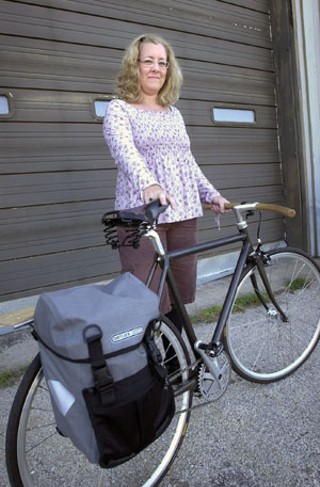
"Biking means lots of different things to all of us, but I think for each of us, it's a way to live our life on our own terms, in some small but significant way. The bike is comforting. It's freedom. In fact, it becomes a highlight of your day. The ride to and from your destinations is the adventure. You can't wait to get outside and on the road to the next place." Rucker, who bike-commutes year-round from Hyde Park to her job at UT, has several extremely sweet cycles, like the one she's pictured alongside here – a handmade fixed-gear bike with custom wood handlebars and rear rack. I've admired Rucker's bikes on her website, www.onechick.com, where she also skillfully photographs and blogs her frequent two-wheeled adventures around Austin. The site offers an unparalleled glimpse into the burgeoning local bike culture, including nighttime group rides often drawing hundreds of riders, unofficial "alley-cat" street races, bike carnivals, and much more.
Rucker's recipe for summer bike fun: "Ride down with your friends to Barton Springs for a free swim at 9pm; jump in, and splash about; get out, and jump directly onto your bike; ride around Downtown; race your friends; stop for a beer or margarita; be happy!"
Lane Wimberley, 43, software engineer
"Our unwitting addiction to cars as our sole means of transportation has been far too costly. Look at what our addiction to cheap oil has gotten us. Look at how many people die each year in car accidents. Do you think people would treat each other face-to-face in public like they treat each other – or bicyclists – when they're in cars?" Wimberley has bike-commuted year-round for more than nine years. His longest commute to a former job was 10 miles each direction. He road races competitively, is a member of the League of Bicycling Voters, and chaired the Infrastructure Subcommittee of the city's Street Smarts Task Force. "I feel that this city would do well to commit resources toward cycling as viable transportation commensurate with our desire – nay, need – to alleviate congestion, improve quality of life and public health, and stimulate the local economy."
Two of his memorable bike-commute experiences: finding thousands of quarters mysteriously strewn across the street one morning and riding past a couple having sex along a hike-and-bike trail.
Got something to say on the subject? Send a letter to the editor.






